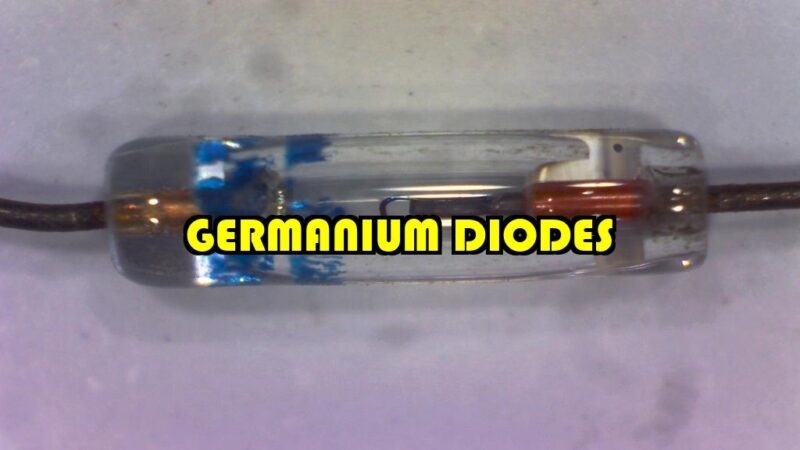In the world of electronics, Germanium diodes stand as pioneers, marking a significant chapter in the evolution of semiconductor technology. From their humble beginnings to their present role in modern electronics, these diodes have played a crucial role in shaping the landscape of electronic devices.
History of Germanium Diodes
Through into the past, the journey of These diodes unfolds, tracing its roots back to the early developments in semiconductor physics. This section explores the key milestones that led to the discovery and utilization of These diodes in various applications.
Properties of Germanium Diodes
Semiconductor Characteristics
Germanium diodes, being semiconductor devices, exhibit several characteristic behaviors related to their electrical properties. Here are some semiconductor characteristics specific to germanium diodes:
-
Band Gap:
- Germanium, as a semiconductor material, has a smaller band gap compared to silicon. The band gap is the energy difference between the valence band and the conduction band. In germanium, this gap is smaller, allowing electrons to more easily transition from the valence to the conduction band.
-
Intrinsic Carrier Concentration:
- Germanium has a higher intrinsic carrier concentration than silicon. This intrinsic carrier concentration determines the number of charge carriers (electrons and holes) in the absence of any external influences.
-
Doping:
- These are often doped with impurities to modify their electrical properties. The most common dopants are either pentavalent (donor) or trivalent (acceptor) elements, introducing extra electrons or holes, respectively, into the crystal lattice.
-
N-Type and P-Type Germanium:
- Doping with pentavalent impurities (e.g., phosphorus) creates N-type germanium, where the majority charge carriers are electrons. Doping with trivalent impurities (e.g., gallium) creates P-type germanium, where the majority charge carriers are holes.
-
Forward Bias:
- When a forward bias voltage is applied across a germanium diode (positive voltage to the P-type side and negative to the N-type side), the majority charge carriers move towards the junction. Electrons move from the N-type to the P-type region, and holes move in the opposite direction.
-
Forward Voltage Drop:
- These diodes typically have a lower forward voltage drop (around 0.3 to 0.4 volts) compared to silicon diodes. This is the voltage at which the diode starts conducting current in the forward direction.
-
Reverse Bias:
- When a reverse bias voltage is applied (positive voltage to the N-type side and negative to the P-type side), the majority charge carriers are pushed away from the junction, creating a depletion region. These diodes have a lower reverse breakdown voltage compared to silicon diodes.
-
Temperature Sensitivity:
- These diodes exhibit a higher temperature sensitivity compared to silicon. As the temperature increases, the intrinsic carrier concentration in germanium also increases, affecting the diode’s electrical characteristics.
-
Rectification:
- These diodes, like all diodes, exhibit rectification properties. They allow current to flow easily in one direction (forward bias) while offering high resistance in the opposite direction (reverse bias).
Temperature Sensitivity
The temperature sensitivity of it refers to how their electrical characteristics change in response to variations in temperature. These diodes exhibit specific temperature-dependent behaviors due to the intrinsic properties of the semiconductor material. Here are key aspects of the temperature sensitivity of it:
-
Forward Voltage Drop:
- One notable temperature-sensitive characteristic is the forward voltage drop across the germanium diode. As the temperature increases, the forward voltage drop tends to decrease. This is in contrast to silicon diodes, which generally exhibit less temperature sensitivity in this regard.
-
Band Gap Narrowing:
- Germanium has a smaller band gap compared to silicon. With increasing temperature, the band gap of germanium narrows further. This phenomenon affects the energy required for electrons to move from the valence band to the conduction band.
-
Carrier Concentration:
- Temperature influences the intrinsic carrier concentration in germanium. Higher temperatures lead to an increase in the number of free electrons and holes in the semiconductor material, impacting its conductivity.
-
Reverse Leakage Current:
- The reverse leakage current of these diodes tends to increase with rising temperatures. This is the current that flows in the reverse direction when a voltage is applied in the opposite direction. The higher reverse leakage current can be attributed to the increased carrier concentration.
-
Breakdown Voltage:
- The breakdown voltage in reverse bias conditions is also affected by temperature changes. Germanium generally have a lower reverse breakdown voltage compared to silicon diodes, and this voltage may decrease further with elevated temperatures.
-
Thermal Stability:
- Germanium diodes, due to their higher temperature sensitivity, are generally considered less thermally stable than silicon diodes. Silicon diodes are often preferred in applications where temperature stability is critical.
-
Application Considerations:
- Engineers designing circuits with germanium need to consider the temperature dependence of these diodes. Compensation circuits or temperature stabilization techniques may be necessary in applications where precise temperature-independent behavior is required.
-
Historical Context:
- The temperature sensitivity of germanium was a significant consideration in early electronics designs. As technology advanced, silicon diodes became more popular due to their improved stability and reduced sensitivity to temperature variations.
Applications of Germanium Diodes
Early Radio Technology
The advent of these diodes coincided with the booming era of radio technology. Uncover the pivotal role these diodes played in the early days of wireless communication.
Signal Detection
The ability of Germanium to detect signals paved the way for advancements in electronic communication. This section delves into the significance of their role in signal detection.
Crystal Radios
A fascinating application of Germanium diodes lies in crystal radios. Explore how these diodes were integral components in the construction of simple yet effective crystal radio sets.
ALSO READ: CO2 VS Laser Diodes: Which One Is Best For You!
Advantages and Disadvantages of Germanium diodes
Advantages of Germanium Diodes
-
Lower Forward Voltage Drop:
- Germanium diodes typically have a lower forward voltage drop (around 0.3 to 0.4 volts) compared to silicon diodes. This makes them suitable for low-voltage applications and can be advantageous in certain circuit designs.
-
Faster Switching Speed:
- Germanium diodes can have faster switching speeds compared to silicon diodes. This property can be beneficial in high-frequency applications and certain fast-switching circuits.
-
Historical Significance:
- Germanium diodes played a crucial role in the early development of semiconductor technology. They were widely used in the mid-20th century and are historically significant in the evolution of electronic devices.
-
Compatibility with Older Systems:
- In certain vintage or historical electronic systems, germanium diodes may still be preferred or required for compatibility reasons. Engineers working on restoration or repair of older equipment might find germanium diodes suitable for maintaining authenticity.
Disadvantages of Germanium Diodes
Temperature Sensitivity:
- Germanium diodes exhibit higher temperature sensitivity compared to silicon diodes. The forward voltage drop and other electrical characteristics can vary significantly with temperature changes, making them less stable in varying thermal conditions.
-
Lower Reverse Breakdown Voltage:
- Germanium diodes generally have a lower reverse breakdown voltage compared to silicon diodes. This makes them more susceptible to damage when exposed to reverse-bias voltages beyond their specified limits.
-
Higher Reverse Leakage Current:
- Germanium diodes tend to have higher reverse leakage currents, which are the currents that flow in the reverse direction when a voltage is applied. This can lead to increased power consumption and reduced efficiency in certain applications.
-
Obsolete in Many Applications:
- Due to the limitations mentioned above and the advancements in semiconductor technology, germanium diodes have become largely obsolete in many modern electronic applications. Silicon diodes are now more widely used due to their improved performance and reliability.
-
Limited Availability:
- Compared to silicon diodes, germanium diodes are less readily available in the market. Finding specific types or quantities of germanium diodes may be challenging, and this limitation can impact their practical utility.
-
Compatibility with Modern Systems:
- Germanium diodes may not be suitable for use in modern electronic systems where stability, precision, and compatibility with other semiconductor devices are crucial. Silicon diodes are generally preferred in contemporary circuit designs.
Challenges and Limitations
Germanium diodes, although historically significant, come with several challenges and limitations that have contributed to their reduced usage in modern electronics. Here are some of the key challenges associated with germanium diodes:
-
Temperature Sensitivity:
- One of the primary challenges is the high temperature sensitivity of germanium diodes. The forward voltage drop and other electrical characteristics can vary significantly with changes in temperature. This sensitivity makes it challenging to maintain stable performance in varying thermal conditions.
-
Lower Reverse Breakdown Voltage:
- Germanium diodes generally have a lower reverse breakdown voltage compared to silicon diodes. This limitation makes them more susceptible to damage when subjected to reverse-bias voltages beyond their specified limits. It restricts their use in applications where higher reverse voltage tolerance is required.
-
Higher Reverse Leakage Current:
- Germanium diodes exhibit higher reverse leakage currents compared to silicon diodes. The increased reverse leakage current can lead to higher power consumption and reduced efficiency in certain electronic circuits.
-
Limited Availability:
- Finding specific types or quantities of germanium diodes can be challenging, as they are less readily available in the market. This limitation can pose difficulties for engineers and hobbyists seeking to use germanium diodes in their projects.
-
Obsolete Technology:
- Germanium diodes belong to an older generation of semiconductor technology. As newer and more advanced semiconductor materials, such as silicon, became prevalent, the use of germanium diodes diminished. The technology is considered outdated for many contemporary applications.
-
Compatibility Issues:
- Germanium diodes may not be compatible with modern semiconductor devices and integrated circuits. This lack of compatibility can be a significant limitation in designing circuits that require seamless interaction between different semiconductor components.
-
Performance Compared to Silicon Diodes:
- In terms of electrical performance, silicon diodes generally outperform germanium diodes in terms of stability, reliability, and tolerance to environmental conditions. Silicon diodes have become the preferred choice in most electronic applications.
-
Historical Context:
- While germanium diodes have historical significance, their limitations have led to the development and adoption of more advanced semiconductor materials. The historical context and vintage nature of germanium diodes may limit their use in contemporary electronic designs.
Conclusion
In concluding this journey through the history, properties, applications, and challenges of Germanium diodes, it’s evident that these humble components have left an indelible mark on the world of electronics.









